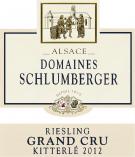History
Ranked among the best wines in the world, the Riesling is one of Alsace’s biggest successes. Introduced in the 15th century, and originating from the Orleanois region, it is different from its German counterpart and from the numerous Riesling, which can now be found a little all over the world. A late-ripening grape variety, it continues to ripen at low temperatures, but gives marvelous results when there is a sunny, dry, late summer. First distinguished in 1699, Kitterlé has always had an exceptional reputation. Already protected in the middle ages, it has been sold under its own name since 1830.
Location
This volcanic-sandstone plot is on a unique site, on a steeply slopiong rocky outcrop facing three ways (south-west, south and south-east). The light, sandy soil, which is kept back by huge drystone walls, only gives very low yields (25 to 35 hl/ha).
Wine-making
The grape are hand-picked and whole bunches are pressed. There is static settling of the lees. The wine is fermented in temperature-controlled tuns, followed by raising on the less for 8 months.
Gastronomy
I would like to enjoy this wine before the meal, with a scampi salad and sweet spices or a lobster carpaccion and fennel. Ideal with a dry goat cheese such as Picodon from the Drôme. Served at 12°C.
Learn more about food & wine pairingTasting
The colour is lemon yellow with light green reflections, of average intensity. The disk is bright, limpid and transparent. The wine shows youth.
The nose is marked and pleasant, with a deep intensity. Racy, we perceive a dominant of rich aromas, candied, fruity, citrus fruits, lemon, orange, spices and ginger. Airing enhances the previously perceived aromas, it strengthens the citrus fruits and reveals a delicate and flinty mineral trace. The nose plays on a register characterising this ‘fresher” vintage. However, the range of scents maintains a nice overall precision. A great nose !
The onset in the mouth is dense, fleshy and compact. The alcohol support is balanced. The wine evolves in a clean and lively medium, pithy and marked by a sparkling note. The range of aromas is similar to that of the nose, a fruity dominance, with citrus fruits, lemon, orange, spices, ginger, a light floral note along with this underlying complex mineral touch. We perceive also a hint of bitterness. The finish has a good length, 7-8 caudalies, lively with a lingering bitterness. The balance of this wine is focused on freshness. The terroir expresses a remarkable density. The mineral precision will be optimal in 5 years.
Technical sheet by M. Pascal Leonetti
“Best Sommelier of France 2006”
















